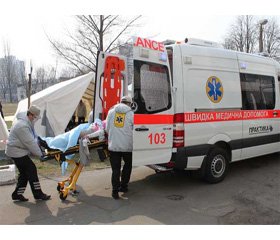Журнал «Медицина неотложных состояний» 2 (65) 2015
Вернуться к номеру
Providing emergency care to the civilian population (organization, anaesthesia, intensive care) for mass casualty during the war
Авторы: A.N. Kolesnikov
Рубрики: Медицина неотложных состояний
Разделы: Справочник специалиста
Версия для печати
Only few doctors have had experience in combat trauma care especially in mine and blast injuries and with mass casualties. The most important are the organizational measures to mobilize available resources (medical staff, respirators, monitoring and other equipment, drugs) and their effective use.
For the period of 3 months (July-September 2014) we have experience in treating over 220 injured civilians mine-explosive and shrapnel and seldom gunshot wounds (7 of them where children) in the intensive care unit (ICU) and 348 urgent resuscitation and anesthesia.
Mine-explosive and shrapnel wounds are the most disabling and difficult to treat. Mass casualties admitted to the emergency department from the site of the explosion usually have combined nature of injures. At the same time, there is a main locus morbi (traumatic injury or amputation of limb with the trauma of the neurovascular bundle, penetrating injury to the abdomen or chest, penetrating injuries CNS) and multiple shrapnel wounds all over the body. These multiple injuries can significantly aggravate the patient's condition as a result of their pain, bleeding, infection, followed by suppuration. In addition, the essential features of modern fragmentation ammunition is the small size of the fragments, high speed and penetrating power, and small size of the inlet. During the blasts and the expansion of the fragments, unlike adults who suffer from limb injures in children more likely to suffer chest / abdomen and head. Thus, the smaller the child, the greater the likelihood of penetrating traumatic brain injury (TBI).
In case of combined injuries of the skeleton and the abdominal or thoracic cavity, the spinal cord or brain in treatment process must be immediately involved various specialists (trauma, surgery, neurosurgery). In these circumstances, the role of coordinator can and in many cases should execute the most experienced anesthesiologist. He should actively participate in discussion of sequence of surgical intervention and additional diagnostic procedures. The paramount role in combined injures played computer tomography (CT) of all injured regions in polytrauma regimen.
During the medical triage patient with erectile phase of shock have to be concerned because their severity could be underestimated. After conducting triage all efforts should be made to minimize blood loss and speedy delivery the most severely injured to the operating room. Patients with combined injures, in many cases, should be simultaneously operated by two surgical teams (eg. intra-abdominal bleeding stop and decompression craniotomy for hematoma removing).
During the massive bleeding beside the hemostasis efforts should be made to perform an immediate blood transfusion (erythrocytes and frozen plasma). Before the stop of bleeding the pressure should be kept at the quite low level to decrease blood loss. In case of reduction blood pressure to a level that threatens the perfusion of vital organs we have positive experience with small volume fluid resuscitation with the adding of an adrenaline to a crystalloid solution. As far as our colloid supplies have been run out we stopped their usage and replace them with crystalloids without any visible impairment of hemodynamic and results of treatment. In emergency department, at first should be performed catheterization of 2 peripheral veins but central line placement is time consuming and in most cases should postponed until operation room.
We experienced the termination of the central supply of the medical oxygen and luck it in the most of operation rooms. In the absence of medical oxygen we switched from inhalation anaesthesia to total intravenous anaesthesia (often with ketamine and sodium oxybutirate) and start to use regional anaesthesia (sinal, epidural and conductive blocks). In the absence of central oxygen supply the paramount role played oxygen concentrator which allowed us to perform safely neurosurgical and other operations.
Many patients admitted to the hospital with already sutured wounds but without properly conducted primary wound debridement. In wounds where often found remained fragments, hematoma, detritus, pieces of clothing, etc. During the treatment of such wounds in the emergency room several times opened arterial bleeding.
Most patients at admission had inadequate analgesia and according to our experience the most important factor in the treatment of traumatic shock is the early usage of powerful analgesics (such as morhine) or performing of a regional anaesthesia.
As result of our experience we created a sample list of medication that has to be available for treatment of each victim. Such list helped us to improve supplies of our emergency department and facilitate the planned purchase of medicines.
In conclusion it has to be underlined, that the most important things in treatment of the mass casualty of the civilian population are the organizational aspects, professionalism of the doctors and their wiliness to help patients.

